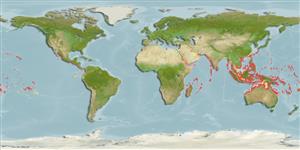Common names from other countries
Environment: milieu / climate zone / depth range / distribution range
Ökologie
seewasser riff-verbunden; tiefenbereich 0 - 36 m (Ref. 9710). Tropical; 30°N - 25°S
Indo-Pacific: Red Sea to the Line, Marquesan, and Ducie islands, north to the Ryukyu Islands, south to Lord Howe and Rapa islands.
Size / Gewicht / Alter
Maturity: Lm ? range ? - ? cm
Max length : 22.0 cm TL Männchen/unbestimmt; (Ref. 90102)
Rückenflossenstacheln (insgesamt) : 6; Rückenflossenweichstrahlen (insgesamt) : 9 - 10; Afterflossenstacheln: 3; Afterflossenweichstrahlen: 36 - 45. This species is distinguished by the following characters: body depth 1.8-2.4 in SL; dorsal soft rays usually 9; pectoral rays 16-18, usually 17; gill rakers 9-7 + 19-26; caudal fin forked. Colour overall of body copper-brown, black spot at pectoral-fin base; anterior edge of first dorsal fin blackish; basal part of anal fin dusky greyish; no black margin on anal and caudal fins (Ref. 90102).
Occurs in clear, shallow lagoon and seaward reefs, quite common along the reef margin. Feeds on benthic and planktonic crustaceans, other small invertebrates, and fishes at night. By day, it forms aggregations in caves. Minimum depth reported taken from Ref. 128797.
Life cycle and mating behavior
Maturities | Fortpflanzung | Spawnings | Egg(s) | Fecundities | Larven
Myers, R.F., 1991. Micronesian reef fishes. Second Ed. Coral Graphics, Barrigada, Guam. 298 p. (Ref. 1602)
IUCN Rote Liste Status (Ref. 130435)
CITES (Ref. 128078)
Not Evaluated
Bedrohung für Menschen
Harmless
Nutzung durch Menschen
Fischereien: weniger kommerziell; Aquarium: Kommerziell
Tools
Zusatzinformationen
Download XML
Internet Quellen
Estimates based on models
Preferred temperature (Ref.
115969): 25.5 - 29.3, mean 28.4 (based on 3053 cells).
Phylogenetic diversity index (Ref.
82804): PD
50 = 0.5000 [Uniqueness, from 0.5 = low to 2.0 = high].
Bayesian length-weight: a=0.01259 (0.00601 - 0.02639), b=3.02 (2.84 - 3.20), in cm Total Length, based on LWR estimates for this species & Genus-body shape (Ref.
93245).
Trophic level (Ref.
69278): 3.6 ±0.49 se; based on food items.
Widerstandsfähigkeit (Ref.
120179): hoch, Verdopplung der Population dauert weniger als 15 Monate. (Preliminary K or Fecundity.).
Fishing Vulnerability (Ref.
59153): Low vulnerability (12 of 100).
